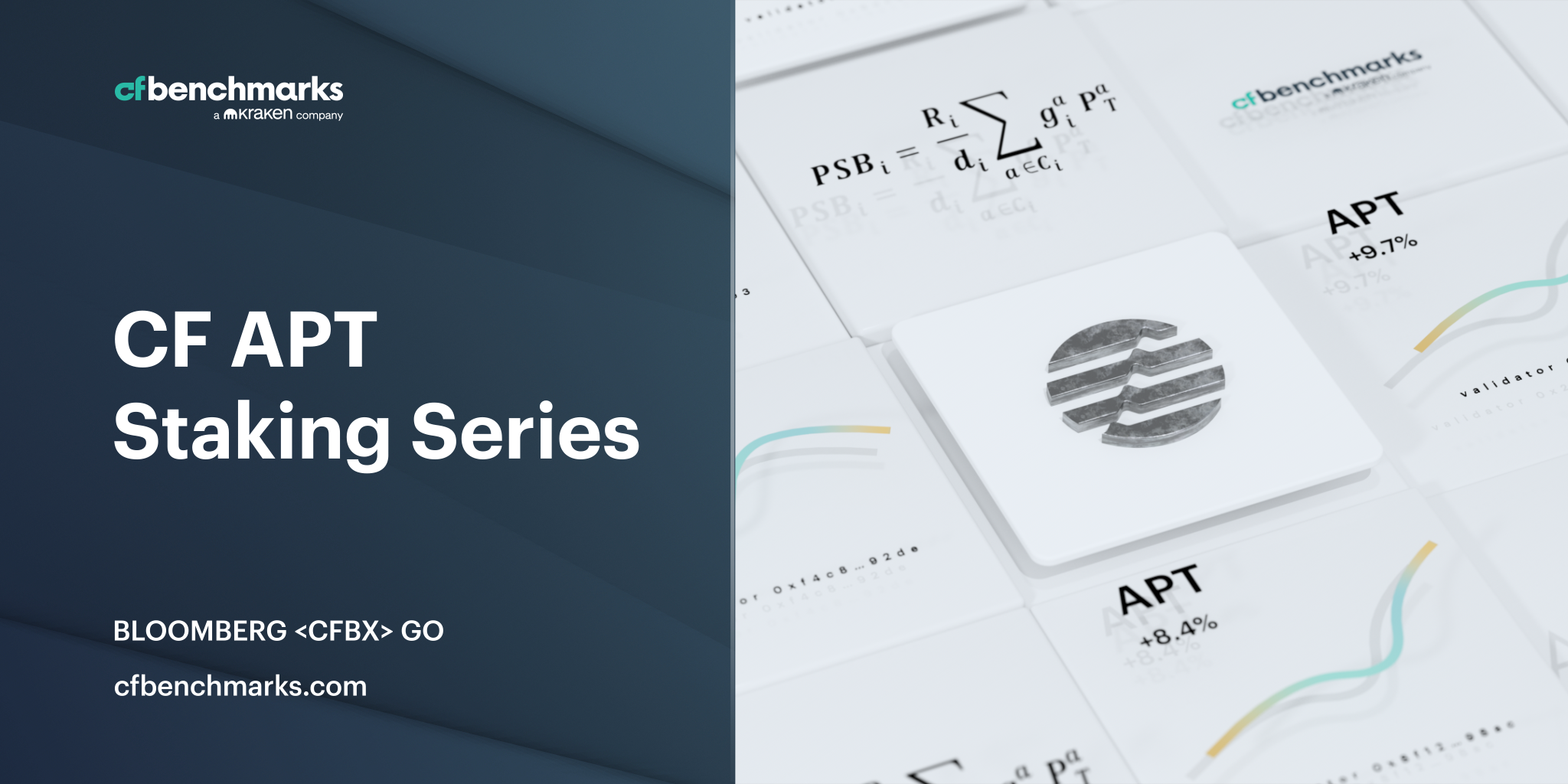CF Benchmarks expands CF Staking Series with first regulated APT Staking indices
CF Benchmarks is excited to announce the launch of the CF APT Staking Reward Rate, the CF APT Staked Return Index, and CF APT Staking Blend Baskets.

Aptos becomes third PoS protocol covered by CF Benchmarks' staking series
Clarity for APT staking rewards
CF Benchmarks is excited to announce the launch of the CF APT Staking Series as the latest addition to our CF Staking Series, a set of transparent and representative indicators of daily realized rewards associated with digital asset staking protocols.
The CF APT Staking Series is a range of indices within the CF Staking Series, providing measures of rewards for APT staking on its native blockchain, Aptos.
CF APT Reward Rate, Index and Blends
The CF APT Staking Series is comprised of the following key benchmarks:
- CF APT Staking Reward Rate (APT_SRR) – a daily calculation of the annualized percentage reward rate for staking APT
- CF APT Staked Return Index (APTUSD_SRIC) – a daily computation that captures the comprehensive total performance of staked APT, quoted in U.S. dollars
- CF APT Staking Blend Baskets (5 variants) – these represent the portfolio performance of specific ‘blends’ of staked APT assets, and non-staked APT assets. Assets in each variant are of fixed weight, and each blend is rebalanced quarterly
About Aptos: high speed, notable pedigree
Meta roots
Following its mainnet launch in 2022, the Aptos Proof-of-Stake (PoS) blockchain has garnered much attention, partly due to its origins, having been developed by Aptos Labs, a firm founded in 2021 by former Meta engineers who’d worked on the now defunct Diem project.
High speed
The network has also gained renown due to its competitive transaction speeds. The Aptos Foundation reported average 3-day observed peak transactions per second (tx/s) of approximately 6,200 in August 2024.
Potential
Aptos has also exhibited strong growth in terms of total value locked (TVL) which stood at around $1.3bn in late-May 2025, ranking the chain 10th by this measure. Meanwhile, user growth has also been impressive, with monthly active users of 15 million in Q1 2025 (ranking Aptos 4th). Aptos’ still modest free-float market cap, of about $3.3bn at the time of writing, suggests potential for considerable price upside should fundamentals continue to strengthen in the medium term.
The Regulated APT Staking Solution
Cogent choice
With continued growth across many metrics likely on the horizon for Aptos, and the increased institutional participation this will attract, APT is a cogent choice for the next set of CF Benchmarks Staking indices.
Just like for all our regulated benchmarks, CF APT Staking Reward Rate is designed to defray risks related to data reliability, accuracy, representativeness, and potential market manipulation, among other possible concerns.
Institutional assurance
As regulated benchmarks under the UK Benchmarks Regulation (BMR) framework, CF APT Staking indices aim to promote replicability, representativeness and manipulation resistance, assuring financial product providers engaging in non-custodial staking on the Aptos blockchain of the highest standards of market integrity and capital efficiency.
Methodology overview
Key elements
The CF APT Staking Reward Rate is calculated daily, aiming to represent the reward rate obtained when staking APT on its native blockchain. The rate is formulated in annualized percentage form. The most important elements of the calculation process are outlined below.
- The CF APT Staking Series observes all delegated pools managed by validators for its calculation
- Note that rewards are distributed by the Aptos protocol net of staking service provider fees
- Reward tokens must be in the form of the digital asset native to the blockchain (for Aptos, that is APT)
- The published reward rate will be the aggregation of rewards observed across all active validator pools
Calculation safeguards
- A Potential Erroneous Reward Rate Parameter is applied to exclude pools exhibiting data that deviate from the network median
- Active validator pools only: Only validator pools active for every epoch within any given 24-hour observation window are included in the index. (An epoch is defined as a duration of time during which a number of blocks are voted on by validators, the validator set is updated, and rewards are distributed to validators)
Aptos-specific components
While the CF APT Staking Series index design closely aligns with the framework for other CF Staking Series indices, there are a few key ways the Aptos index calculation differs. These are detailed below.
1. Delegated pool level observations
The first concerns the position within the validation process at which observations for the index calculation are undertaken. Note that each Aptos validator can operate only one delegated pool to which clients delegate APT; and that validators receive commissions deducted at protocol level. Therefore, observations at delegator pool level represent the reward rates clients receive more accurately than reward rate observations at the validator level. Meanwhile, note that validators earn rewards for both staking their own APT as well as for operating validator nodes used by delegators. By observing reward rates at the delegator level, the CF APT Staking Reward Rate tracks rewards related only to capital allocation, providing a better representation of the economic reality for reward rates
2. Network-wide observations
Note that the CF Aptos Staking Reward Rate also differs from other CF Staking Reward Rate indices in that observations from which its calculation is derived originate from delegated pools across the entire network. This is because unlike Ethereum and Solana – the other protocols for which CF Benchmarks publishes CF Staking Reward indices – Aptos does not currently exhibit undue risks related to validator heterogeneity and number. This means comprehensive and network-wide observations are both representative and replicable. By contrast, our Ethereum and Solana Reward Rate indices focus only on select validators or validator pools, due to the potential for undue risks associated with the broader network's heterogeneity and extensive validator base.
Read the full CF Staking Series Methodology Guide (May 20th, 2025) here
Institutional use cases
The flexibility offered by our suite of CF APT Staking indices, together with their transparency, representativeness and high standards of market integrity, opens a wide range of institutional use cases.
We outline the key ones below.
- Internal performance benchmarking for managers of APT holdings as a component of products offered to clients, or by capital markets participants, e.g. market makers, providing liquidity in staked APT
- Investment managers can devise funds tracking the CF APT Staked Return Index, or one of the CF APT Staking Blend Baskets, secure in the knowledge that the benchmarks represent the most accurate possible pricing of staked APT returns
- Market makers may deploy the CF APT Staking Reward Rate Index as the direct contract counterparty in swap contracts
- Staking Service Providers may utilize CF APT Staking indices as market benchmarks, for balance sheet management, internal risk, or reporting purposes, among others
Conclusion
In summary, our new CF APT Staking Reward Rate Index and its supplementary sub-series benchmarks, the CF APT Staked Return Index, and CF APT Staking Blend Baskets, introduce higher standards of trustworthiness, flexibility and price integrity for the most important aspect of APT staking for institutional participants, the reward rate itself.
More information
- CF APT Staking Reward Rate Index web page
- CF Staking Series Methodology Guide
- CF Staking Series Product Page
The information contained within is for educational and informational purposes ONLY. It is not intended nor should it be considered an invitation or inducement to buy or sell any of the underlying instruments cited including but not limited to cryptoassets, financial instruments or any instruments that reference any index provided by CF Benchmarks Ltd. This communication is not intended to persuade or incite you to buy or sell security or securities noted within. Any commentary provided is the opinion of the author and should not be considered a personalised recommendation. Please contact your financial adviser or professional before making an investment decision.

